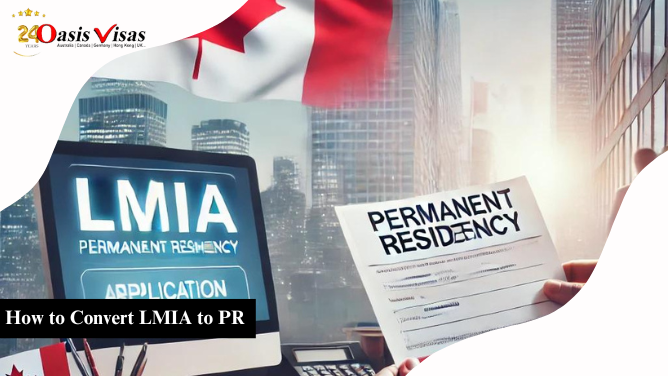
There are several ways through which immigration to permanent residency in Canada for foreign workers can take place. The most straightforward route for skilled workers is via LMIA, or Labour Market Impact Assessment. An LMIA is a document an employer in Canada may need to hire a foreign worker-a proof, in other words, that there are no Canadians or permanent residents who are ready to carry out the said job. If you are employed already in Canada on an LMIA work permit, the question possibly in your mind is how to convert your LMIA to PR. In fact, this article will show you the step-by-step process to do so for those who work in Canada on an LMIA-based work permit.
Understanding LMIA and Its Role in PR
The LMIA is a document that shows a Canadian employer has been granted permission by the government to hire a foreign worker. It is not an immigrant visa, per se, but it plays a major role in facilitating an individual’s journey from holding a temporary work permit to obtaining permanent residence in Canada. Many skilled foreign workers ultimately apply for permanent resident status under one of several federal or provincial immigration programs in Canada after arriving in the country on work permits issued based on an LMIA.
The LMIA-to-PR process includes eligibility criteria and application through the proper immigration program. Most applications for permanent residency occur via the Express Entry system; however, Provincial Nominee Programs are an equally popular option.
Step-by-step process
Step 1: Get Information About Express Entry
One of the most popular routes of conversion of LMIA to PR is through the Express Entry system. It’s an online system that was developed to manage applications for permanent residency under the following programs:
- Federal Skilled Worker Program (FSWP)
- Federal Skilled Trades Program (FSTP)
- Canadian Experience Class (CEC)
In such cases, when you have a valid LMIA, it may increase your Comprehensive Ranking System score by a wide margin that could be helpful in getting an invitation to apply for permanent residency. The Comprehensive Ranking System ranks candidates based on age, level of education, linguistic abilities, work experience, and more. A valid LMIA can add up to 200 points to your CRS score, depending on the type of job.
Step 2: Meet Eligibility Criteria
In order for you to turn your LMIA into PR, you have got to make sure that you fit into the eligibility criteria of one of the programs handled by Express Entry. The programs have specific elements touching on:
- Work experience: You need at least one year of work experience in a skillful job in Canada or abroad; the program will determine which.
- Language Proficiency: You need to take a language test approved and reach the required level of proficiency in either English or French.
- Education: You need to have a foreign degree, diploma, or certificate, or its Canadian equivalent. If you studied outside Canada, you need to obtain an Educational Credential Assessment report.
- Job Offer: A valid job offer with LMIA implies that the chances of your ITA for PR are improved.
The CEC program gives an advantage to a candidate who has his work experience in Canada while FSWP gives an advantage to a person who has foreign skilled work experience.
Step 3: Submit an Express Entry Profile
Once you get qualified, the next thing you need to do with your LMIA in order to turn it into PR is to create an Express Entry profile. The profile is your Expression of Interest in going to Canada. Make sure all your details of a job, work experience, education, and language skills are correctly filled out.
The information you provide will automatically translate into a CRS score for your Express Entry profile. A job offer supported by LMIA is one of those more critical factors that contribute toward achieving a high score to receive an ITA for PR. Ensure that the information that you provide about LMIA is correct and, more importantly, current, because this is one of the most important elements in scoring your profile.
Step 4: Receive an Invitation to Apply (ITA)
Once you have registered your profile in Express Entry, you will fall into the pool of candidates. If your comprehensive rating system score is high enough, you will be invited to apply for permanent residency during one of the regular draws carried out by the government. An LMIA-supported job offer can greatly increase your chances of receiving an ITA, especially if your initial comprehensive rating system score is low.
Once you have been issued an ITA, you will then have a period of 60 days in which to submit your full application for permanent residency. You are supposed to make all the necessary preparations by procuring any relevant documents during this time including proof of your job offer, LMIA, educational credentials, and language test results.
Step 5: Application for Permanent Residency
With the ITA in your hand, the next step towards converting your LMIA to PR is to apply for permanent residency under the Express Entry system. Documents required include:
- Work experience proof
- Valid job offer and LMIA
- Language test results
- Educational Credential Assessment, if required
- Proof of funds in case it is required
Send in the application along with the processing fee. Normally, the processing time for Express Entry takes six months or less from the time a complete application has been received. At this stage, the government will be working on your application, verifying your documents, and asking for more information if it feels necessary.
Step 6: Obtain the Permanent Residency
Once your application has been selected, you will be issued a COPR and later a permanent resident card. As a permanent resident, you will have the right to live, work, and study anywhere in Canada without restriction. You will also have the opportunity to apply for Canadian citizenship once you meet the residency requirement.
Other Pathways: Provincial Nominee Programs (PNPs)
The other alternative to converting your LMIA to PR, aside from Express Entry, is through Provincial Nominee Programs. Most provinces in Canada have PNPs assigned toward addressing their local labor market requirements. In case you are working in a certain province with an accompanying job offer that is supported by an LMIA, you could be qualified for applying for a nomination under the PNP of that particular province. A provincial nomination will grant you a further 600 points in your CRS score, and that’s virtually a guaranteed ticket for an ITA to permanent residency.
Conversion of LMIA to PR is a major leap toward making Canada your permanent home. One can follow the steps, as mentioned above, namely information gathering, fulfillment of eligibility criteria, creation of an Express Entry profile, getting an ITA, and offering an in-depth application in properly moving from temporary work status to permanent residency. Whether applied for through Express Entry or through a Provincial Nominee Program, a job offer supported by an LMIA can greatly increase one’s chances of being granted Canadian permanent residency to start a new chapter of life in Canada.








